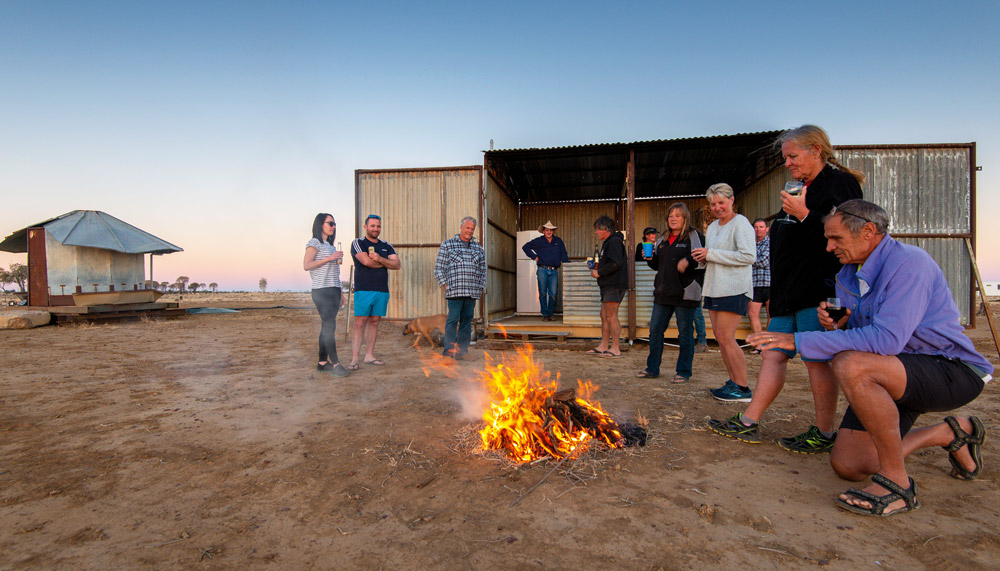Visitors to central-western Queensland might come to see the Stockman’s Hall of Fame, the Qantas Founders Museum and the Australian Age of Dinosaurs, but the things they remember are the open spaces and the people who inhabit them.
Story Kirsty McKenzie Photos Debbie Scott
Arguments have been known to erupt between family members staying at Mitchell Grass Retreat, David Neal says. He and his wife Tanya run the retreat on the outskirts of Longreach, in Queensland’s central west. The glamping venue has 10 luxuriously appointed canvas tents and no creature comforts are sacrificed for the sake of spending a night in the bush.
“Each tent accommodates two people,” David says. “But we give families swags for their children to sleep in. The adults sometimes end up fighting with the kids for the chance to sleep outdoors. Sleeping under the stars is an opportunity many city folk would give their eye teeth for.”
The importance of introducing city folk to a rural way of life is a common theme among hospitality providers across the region. As COVID-19 has clipped the wings of travellers who might normally head overseas for their holidays, they are looking to their own backyard, and so self-drive and organised tours to the bush are booming. Tourism operators all have some experience they want visitors to see, but the common denominator is that the person delivering that experience is most likely a long-time resident and, very often, the owner.
Tambo, population 360-odd, provides a good introduction to the reception travellers can expect. It’s located 914km north-west of Brisbane and 400km north of Cunnamulla. The first thing motorists see is a road sign with a black bear outlined against a yellow background announcing ‘Teddies crossing’. Tambo Teddies began in 1992 as a self-help project to inject business into the town, which was suffering from years of drought and a decline in the wool industry. The founders hit on the idea of making and selling sheepskin teddy bears, giving tourists a reason to stop in town and, hopefully, spend a few extra dollars on fuel or food while there. Today, more than 53,000 teddies down the track, the business is run by former schoolteacher Alison Shaw and one-time Kiwi jillaroo Tammy Johnson.
About an hour (100km) up the road in Blackall, blade shearer Jackie Howe set a record for hand shearing 321 sheep in seven hours, 40 minutes back in 1892. This and other shearing history is recalled at the Blackall Woolscour on the outskirts of town, where visitors can see the country’s last surviving steam-operated wool-washing plant. The facility ran from 1908 to 1978, and is part of a complex that includes a 20-stand shearing shed and a free-flowing artesian bore (most bores these days are capped).
From Blackall it’s another 108km to Barcaldine, a service town on the railway line from Rockhampton, with a population of about 1500. Savvy travellers know to turn off 28km before they get to town for a night or two at Lara Wetlands bush camp. There’s ample space to park a van or pitch a tent at the unpowered campground, which is a feature of a 6000ha cattle station. The wetlands, which contain myriad dead ghost gums, are fed by an artesian bore and attract abundant birdlife – 127 species on the list and counting.
On the other side of the highway, at Dunraven station, visitors meet Peter Doneley and his wife and accomplished baker Roberta, their son Paul, daughter-in-law Ali and grandson George, who all help with the tag-along tours of the station. The experience takes about three hours and includes wildlife encounters, a visit to an artesian bore, an explanation of the livestock in the paddocks and the wild-dog exclusion fence Paul has spent four years building, before it concludes at the shearing shed with a splendid smoko.
The full version of this story was published in both OUTBACK magazine and the 2020 edition of our special one-shot magazine OUTBACK Travel.
This story excerpt is from Issue #135
Outback Magazine: Feb/Mar 2021










